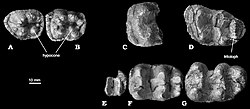| Chilgatherium Temporal range: Late Oligocene | |
|---|---|
 | |
| Scientific classification | |
| Kingdom: | Animalia |
| Phylum: | Chordata |
| Class: | Mammalia |
| Order: | Proboscidea |
| Family: | † Deinotheriidae |
| Subfamily: | † Chilgatheriinae Sanders, Kappelman, & Rasmussen, 2004 |
| Genus: | † Chilgatherium Sanders, Kappelman, & Rasmussen, 2004 |
| Species: | †C. harrisi |
| Binomial name | |
| †Chilgatherium harrisi | |
Chilgatherium ('Chilga beast' after the locality in which it was found) is the earliest and most primitive representative of the family Deinotheriidae. [1] It is known from late Oligocene (27- to 28-million-year-old) fossil teeth found in the Ethiopian district of Chilga.
So far, only a few molar teeth have been found, but these are distinct enough that this animal can be identified with confidence. The teeth differ from those of Prodeinotherium , Deinotherium , and the various barytheres in various details, enough to show that this is a distinct type of animal, and has been placed in its own subfamily. Compared to later deinotheres, Chilgatherium was quite small, about 2 m (6.6 ft) tall at the shoulder and weighed about 1.5 t (1.7 short tons). [2] It is not known if it shared the distinctive downward-curving tusks on the lower jaw that the later deinotheres had.
Chilgatherium disappeared prior to the Early Miocene, when it was replaced by Prodeinotherium.


